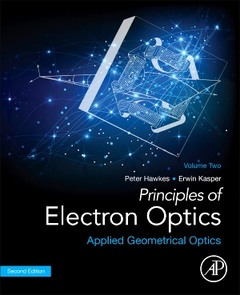Principles of Electron Optics, Volume 2 (2nd Ed.) Applied Geometrical Optics
Auteurs : Hawkes Peter W., Kasper Erwin

Principles of Electron Optics: Applied Geometrical Optics, Second Edition gives detailed information about the many optical elements that use the theory presented in Volume 1: electrostatic and magnetic lenses, quadrupoles, cathode-lens-based instruments including the new ultrafast microscopes, low-energy-electron microscopes and photoemission electron microscopes and the mirrors found in their systems, Wien filters and deflectors. The chapter on aberration correction is largely new. The long section on electron guns describes recent theories and covers multi-column systems and carbon nanotube emitters. Monochromators are included in the section on curved-axis systems.
The lists of references include many articles that will enable the reader to go deeper into the subjects discussed in the text.
The book is intended for postgraduate students and teachers in physics and electron optics, as well as researchers and scientists in academia and industry working in the field of electron optics, electron and ion microscopy and nanolithography.
PART VII – INSTRUMENTAL OPTICS 35. Electrostatic Lenses 36. Magnetic Lenses 37. Electron Mirrors, Low-energy-electron Microscopes and Photoemission Electron Microscopes, Cathode Lenses and Field-emisssion Microscopy 38. The Wien Filter 39. Quadrupole Lenses 40. Deflection Systems
PART VIII – ABERRATION CORRECTION AND BEAM INTENSITY DISTRIBUTION (CAUSTICS) 41. Aberration Correction 42. Caustics and their Applications
PART IX – ELECTRON GUNS 43. General Features of Electron Guns 44. Theory of Electron Emission 45. Pointed Cathodes without Space Charge 46. Space Charge Effects 47. Brightness 48. Emittance 49. Gun optics 50. Complete Electron Guns
PART X – SYSTEMS WITH A CURVED OPTIC AXIS 51. General Curvilinear Systems 52. Magnetic Sector Fields 53. Unified Theories of Ion Optical Systems
Postgraduate students and teachers in physics and electron optics; researchers and scientists in academia and industry working in the field of electron optics, electron and ion microscopy, and nanolithography
Erwin Kasper studied physics at the Universities of Münster and Tübingen (Germany), where he obtained his PhD in 1965 and the habilitation to teach physics in 1969. After scientific spells in the University of Tucson, Arizona (1966) and in Munich (1970), he resumed his research and teaching in the Institute of Applied Physics, University of Tübingen, where he was later appointed professor. He lectured on general physics and especially on electron optics. The subject of his research was theoretical electron optics and related numerical methods on which he published numerous papers. After his retirement in 1997, he published a book on numerical field calculation (2001).
- Offers a fully revised and expanded new edition based on the latest research developments in electron optics
- Written by the top experts in the field
- Covers every significant advance in electron optics since the subject originated
- Contains exceptionally complete and carefully selected references and notes
- Serves both as a reference and text
Date de parution : 12-2017
Ouvrage de 766 p.
19x23.3 cm
Thèmes de Principles of Electron Optics, Volume 2 :
Mots-clés :
Aberration coefficients; Aberration measurement; Aberrations; All-electrostatic corrector; Annular systems; Aperture effects; Aplanat; Arc lens; Astigmatic lens caustics; Astigmatic tube lens; Axial conductors; Bell-shaped model; Biplanar lens; Bipotential lenses; Blade focus; Boersch effect; Brightness function; CEOS; Calculation of space charge distribution; Cambridge STEM project; Canonical mapping transform; Carbon nanotube emitters; Castaing-Henry analyser; Cathode lenses; Cathode matching; Chicago project; Chromatic aberration correction; Classified bibliography of the different devices; Cone focus; Cone-edge focus; Cross focus; Crossed lens; Curved optic axis; Curvilinear coordinates; Cusp; Darmstadt project; Delta corrector; Diode approximation; Dynamic correction of chromatic aberration; EMBL low-voltage SEM; Einzel lenses; Electron lithography; Electrostatic prisms; Emittance diagrams; Emittance ellipses; Energy analysers; Ferrite shields; Field electron emission; Field models; Foil lenses; Forbes-Deane theory; Fowler-Nordheim equation; Fringe-field monochromators; Fringing fields; Fujita-Shimoyama theory; Gauze lenses; Generalized brightness function; Grid lenses; Grivet-Lenz model; Helical axis; High-frequency lenses; High-speed imaging; Holography; Hyperemittance; Ichinokawa analysers; In-column analysers; Intensity distribution; LEEM; Lauer's theory; Lenz's theory of brightness; Line currents; Line focus; Mandoline filters; Mask fabrication; Mean brightness; Mini-lenses; Mirror electron microscope; Mirrors; Model potentials; Monochromators; Moving objective lens; Multi-electron-beam devices; Multielectrode lenses; Multipoles; Möllenstedt analysers; Nakabushi's unified theory; Nion; Octopoles; Optimization; PEEM; PICO; Pancake lenses; Paraxial equations; Permanent-magnet lenses; Pierce guns; Post-column analysers; Practical gun optics; Quadrupoles; Quadrupole-octopole corrector; Radial lens



